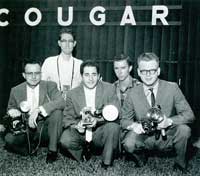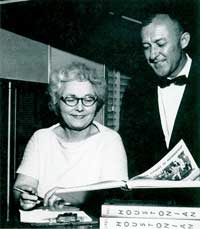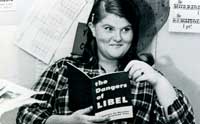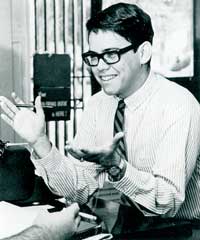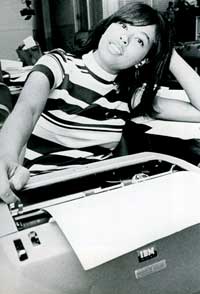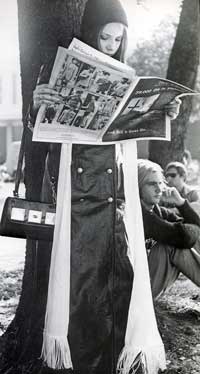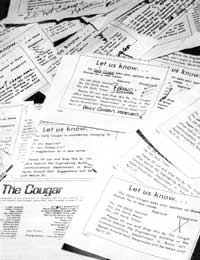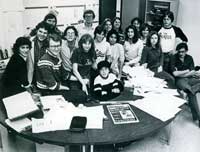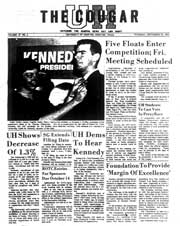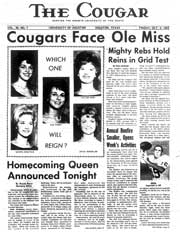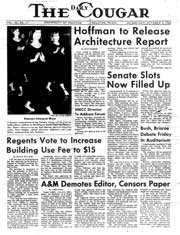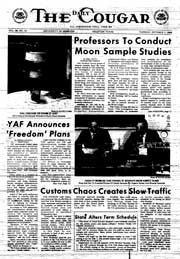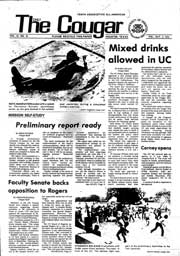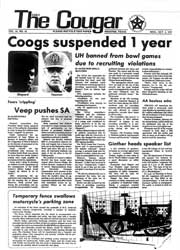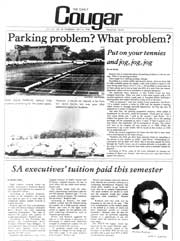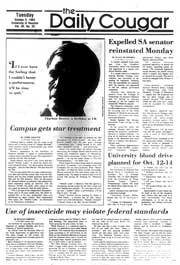1960–1984
Trial by fire?
Try going daily
Disaster struck in March 1960 when a fire destroyed the UH Printing Plant, including the press that N.S. Patterson helped bring to the University. The Cougar was temporarily suspended, but the Houston Chronicle offered its presses to keep the Cougar going. But in order to use the Chronicle's state-of-the-art machines, the Cougar had to adapt its production techniques.
On its old presses, the Cougar was set in a process called "hot type" where lines of type were cast from molten metal, which then composed a column of type that was arranged on a rigid plate that made up the entire newspaper page. This was done for every piece of type, letter by letter, page by page, by hand. Linotype operators were often deaf-mutes who weren't affected by the noise of the giant linotype machines. Of course, they had to be perfect typists — there was no "undo" button once a letter was set in molten metal.
The Chronicle, however, had transitioned to "cold type" in which the type was set onto a sheet that was then photographed with a special kind of camera that produced newspaper-page-sized film. The film image was then burned onto a thin metal plate that could be placed on the press. For Cougar editors, it meant that they could be more inventive with their design, layout and use of typography. It also meant that they could publish photographs more easily.
In the early 1960s, the paper began publishing on Thursdays, as enrollment neared 12,000 with record enrollment of on-campus residents.
By 1962, the Cougar bumped up to a twice-weekly schedule for the first time since the late 1940s. Though the Cougar had its eyes on becoming a daily, Adviser Ross Strader said that generating the necessary ad revenue would be difficult given the lack of local businesses that catered to students and that identified with the University.
Even so, the Cougar branched out by publishing special sections and inserts, and it attracted more classified advertising.
In 1963, The Cougar staff was stunned by the assassination of President John F. Kennedy. At the time, the newspaper had an Associated Press teletype machine which broadcast news from the national AP wire, so the Cougar staff that huddled around the frantic machine that day were among the first at UH to find out about the death of Kennedy.
On Nov. 27, 1963, The Cougar front page showed sorrowful students gathered at a campus memorial service. Even the sports page referenced the tragedy, with one story headlined: "Sports world loses great champion in death of JFK."
The paper and the staff matured quickly under the twice-weekly schedule, and in May 1965, the paper was approved for a press run of four days a week — making it practically a daily.
Then Editor in Chief Edith Bell wrote: "Skeptics have already started saying that The Cougar won't be able to make it as a daily, but they don't take into account that this is a growing university. ... The Cougar will falter but will learn to walk as a daily. This is a really big step toward becoming a really big university."
Once on a daily schedule, the paper expanded its campus coverage and took a closer look at the administration's dealings. Four paid reporter positions were established, in which student journalists were expected to work six-hour days for $5 a day.
Coming of age
The paper, which had once been closely aligned with the administration, became increasingly critical. It also took a strong stance against the Vietnam War. After four students were killed at a Kent State University riot, The Daily Cougar front page read: "1, 2, 3, 4, We don't want your f—ing war."
The Editorial Board also pushed for several initiatives that were very liberal for a Southern campus, including rights to abortion, free contraceptives on campus and the Equal Rights Amendment.
The Cougar closely watched the Apollo progam and its impacts on the city and the university. Regular reports covered the university's reception of several moon rocks for study.
In addition to expanded news coverage, The Cougar began offering an occasional arts and entertainment magazine called Nova, which was published on Mondays. The magazine carried reviews of books, films and music as well as feature articles and interviews. The newspaper also grew in quality and sophistication and was consistently awarded an All-American rating by the Associated Collegiate Press.
The paper was brimming with advertisements in the 1960s and 1970s, especially for alcoholic beverages. ("Now comes Miller time," was a prominent ad campaign.) The newspaper looked and read more like a professional publication. It published its first full-color photo on Nov. 20, 1976 to mark the Cougars' Southwest Conference crown and entry into the Cotton Bowl.
It wasn't long before The Cougar began a campaign to rename the paper to reflect its identity. An editorial in Fall 1976 by Editor in Chief Mike Snyder complained that reporters trying to get press access to events were given trouble about the name of the paper, which Snyder said sounded like it belonged to a high school publication.
Thus began a protracted effort to rename the paper. After some sporadic polling of students over the course of two months, Daily Cougar editors decided to change the name to UH Daily News. The Student Publications Committee approved the change and passed it on to UH President Philip G. Hoffman. Ultimately, Hoffman never approved the change.
The Cougar charged ahead and became a true daily, publishing 5 days a week, with its first Monday edition on March 1978. Editors said at the time becoming a five-day daily had been a goal for several semesters.
Four years later, The Daily Cougar announced it would cut back to a four-day press run after the paper's student fee allocation was cut just as the staff was getting used to its offices in the new Communication Building — a suite of rooms designed for newspaper work, including a business office, yearbook office, ad sales office, two darkrooms and a composing room for ad and page layout.
Along the way, the paper had cut its access to The Associated Press wire, meaning 100 percent of the paper's content was generated by students.
In the 1980s and 1990s, advances in computing and desktop publishing paved the way for rapid changes to how the Cougar was created each day. The staff transitioned from electric typewriters and word processors to Macintosh computers, and by the mid-1990s, the paper was typeset completely with software.
